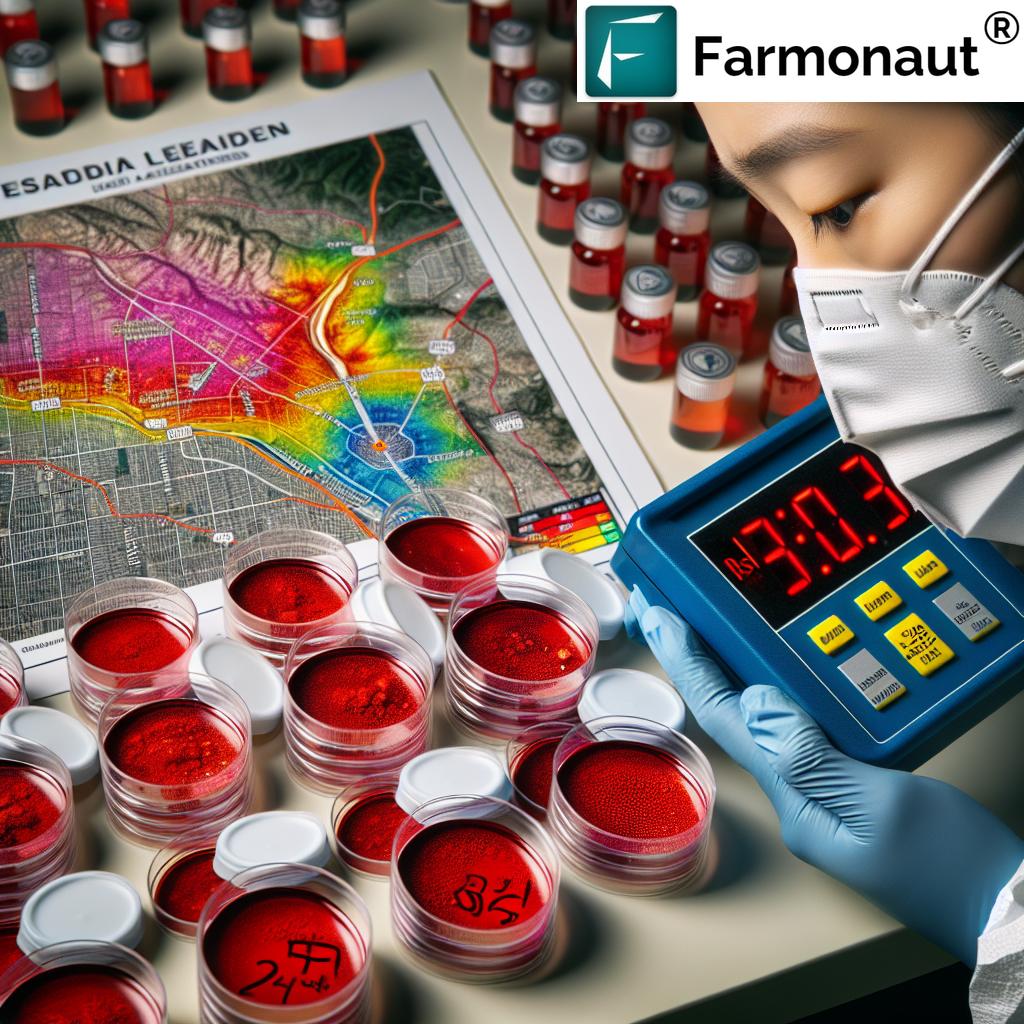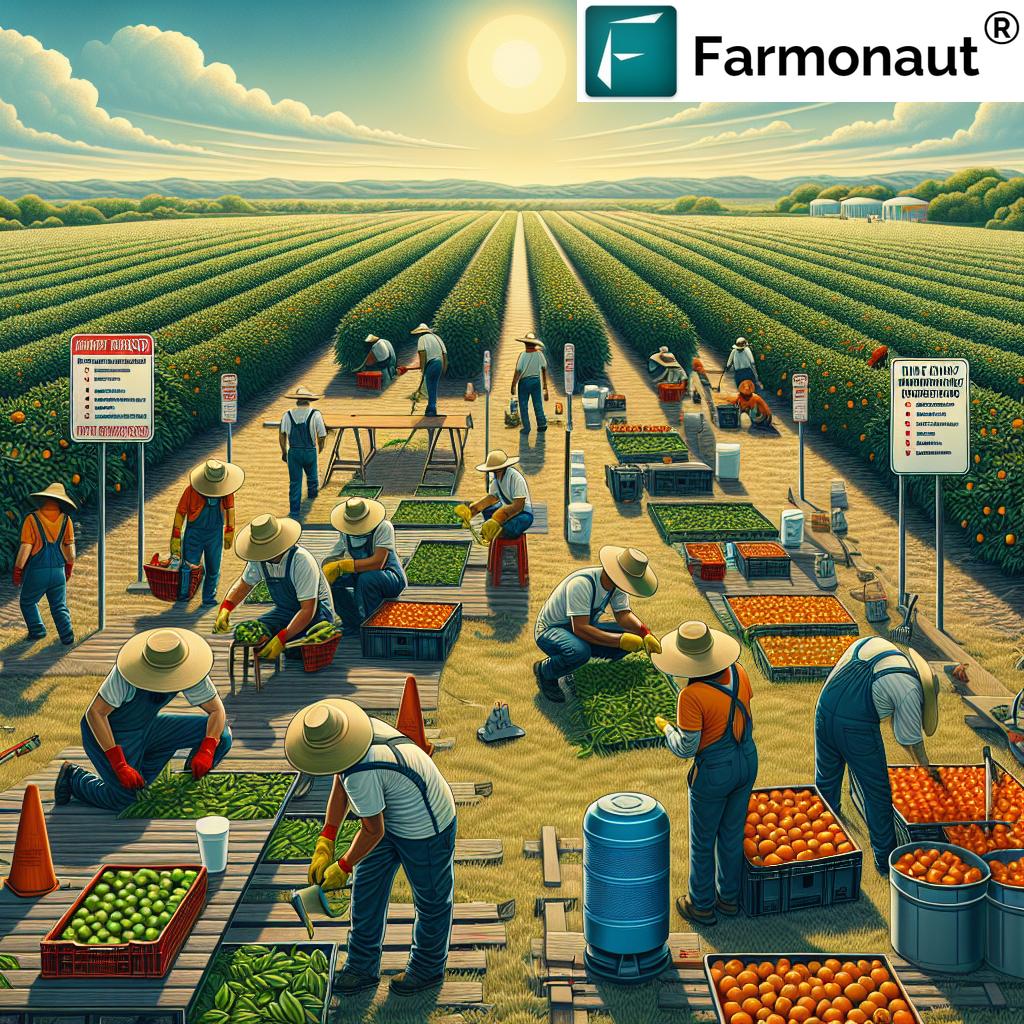Farm Bills, Bill Gates Farms & Hills Sprayer at North Hills: Trends, Technology & Sustainability in 2025 and Beyond
“U.S. farm bills influence over $400 billion in agricultural funding, shaping trends in tech and sustainability every five years.”
“Bill Gates owns over 275,000 acres of farmland—making him America’s largest private farmland owner as of 2025.”
- Introduction: Agricultural Transformation for 2025 & Beyond
- Farm Bills & Policy Reforms: Shaping Agriculture’s Future
- Bill Gates Farms & Farmland Ownership Trends
- Technological Innovations: The Impact of Modern Machinery Like Hills Sprayer
- Local Agricultural Economies: North Hills Farmers Market & Smithills Farm Milk
- Farmonaut: Satellite-Driven Agricultural Innovation
- Comparative Table: Legislation, Technology, & Investment Pre/Post-2025
- Future Insights: Trends Reshaping Agriculture in the United States & Globally
- FAQ: Farm Bills, Technology, & Sustainability in Agriculture
- Conclusion: The Dynamic Future of Agriculture
Introduction: Agricultural Transformation for 2025 & Beyond
The agricultural landscape in the United States and around the globe continues to evolve rapidly as we move into 2025 and beyond. Farm bills, innovative technological advances, and influential landowners like Bill Gates play central roles in shaping how farmers manage farmland, adopt new practices, and ensure sustainability in a world of changing climates and market dynamics.
This comprehensive guide explores:
- The significance of farm bills and their reforms on agriculture.
- The impact of Bill Gates farms and changes in farming land ownership across the U.S.
- The adoption of modern farming equipment like the Hills Sprayer.
- The resilience of local economies and the roles of north hills farmers market and smithills farm milk.
- The role of advanced data solutions, including our work at Farmonaut, in supporting productivity and sustainability.
Dive in as we analyze these topics through the lens of 2025 agriculture, providing actionable insights and examples for farmers, agribusiness, policymakers, and engaged consumers worldwide.
Farm Bills & Policy Reforms: Shaping Agriculture’s Future
The Cornerstone of U.S. Agricultural Policy: What Is a Farm Bill?
Farm bills are comprehensive legislative packages passed every five years by the United States Congress. They underpin the nation’s agricultural and food policy, directly shaping support systems for farmers, conservation efforts, food security programs, and rural development.
The 2023 Farm Bill introduced a wave of reforms aimed at addressing the changing landscape of farming in America:
- Support for Sustainable Practices: Incentives for adopting eco-friendly practices and transitioning towards regenerative agriculture.
- Climate Resilience: Programs to reduce environmental degradation, enhance soil health, and increase farm resilience against climate change.
- Crop Diversification: Funding for research and subsidies to encourage crop diversification and more resilient food systems.
- Conservation Efforts: Expanded support for voluntary conservation programs to preserve farmland and natural resources.
- Technological Research: Dedicated budgets to fund research in precision agriculture, advanced equipment, and sustainability strategies.
The impact is profound: These policies not only support farmers directly, but also shape market conditions, influence what producers grow, and drive advances in agricultural technology.
How 2025 Farm Bill Reforms Shape the Future
As of 2025, the agricultural sector is actively leveraging farm bills to:
- Transition towards Regenerative Agriculture: Farm bills incentivize practices that improve soil health, sequester carbon, and restore biodiversity—essential factors for long-term food security.
- Enhance Climate Resilience: Subsidies for drip irrigation, cover cropping, and reduced tillage allow farmers to increase productivity and adaptability in a changing climate.
- Promote Conservation Stewardship: Greater emphasis is placed on land stewardship, with robust frameworks to preserve wetlands, grasslands, and wildlife habitats alongside working farmland.
- Fund Technology and Research: New resources enable rapid deployment of advanced technologies—from precision equipment to digital management tools—supporting both productivity and environmental objectives.

Our web app helps visualize sustainable field management using current and historical satellite imagery. Monitor crop health, measure carbon sequestration progress, and support compliance with policy requirements directly on your phone or computer.
In summary, farm bills are more than regulatory documents; they are living blueprints that directly influence the future of agricultural practices, innovation, and sustainability.
Evolution of Farm Bill Priorities in 2026
By 2026 and beyond, we anticipate further market shifts as farm bills integrate near-real-time environmental monitoring technologies into eligibility for subsidies and funding. Blockchain and satellite data will streamline reporting, proving compliance and providing transparency for consumers demanding sustainable products. The trend is clear: alignment with technology and ecological stewardship will remain a central pillar of U.S. and global agricultural policy.
Bill Gates Farms & Farmland Ownership Trends
Bill Gates: The Largest Private Farmland Owner in the U.S.
The accumulation of farmland by major investors in recent years has sparked both fascination and debate. Bill Gates farms set the gold standard. According to verified land registry data, Gates now owns over 275,000 acres of farming land across multiple states—making him the largest private farmland owner in America as of 2025.
The scope, landscape, and strategic value of these holdings include:
- Diverse Farmland: Bill Gates’s holdings span rich croplands in North Dakota, Washington, California, and Louisiana, as well as acres of pasture, organic conversions, and research fields.
- Technological Test Beds: Gates’s farms are often seen as testbeds for advanced farming techniques, including precision irrigation, drone-based monitoring, and machinery like the Hills Sprayer.
- Influential Investor Role: Presence of large-scale, tech-driven actors like Bill Gates is shifting how policy, research, and local markets align with global food security challenges.
The debate over bill gates farming land raises critical questions for the industry:
- Does consolidated ownership increase innovation or threaten local producer diversity?
- Do testbed operations driven by tech investors help increase yields and reduce carbon footprint?
- How do large holdings influence smaller producers, local markets, and sustainability?
What’s clear is that tech-driven, sustainable agricultural innovation is on the rise, from Gates’s farmlands to local networks across the U.S. Advanced equipment and data technologies—such as satellite monitoring and precision sprayers—are increasingly piloted in these large-scale settings before wider adoption.
Ongoing Shifts: What Does This Mean for U.S. and Global Farmland?
- Policy Impact: Farm bills are adapting to address the concentration of farmland ownership and incentivize shared access to data and sustainable innovations.
- Environmental Stewardship: Gates’s investment firm advocates for climate-smart agriculture and water-efficient irrigation—practices gaining traction industry-wide as environmental priorities escalate.
- Transition Curve: The rise in large-scale investment is balanced by a parallel movement to support local producers, community-based economies, and regenerative models.
As the farm landscape continues to evolve rapidly, the ongoing discussions around ownership, stewardship, and innovation reshape what it means to be a farmer in 2025.
Technological Innovations: The Impact of Modern Machinery Like Hills Sprayer
Machinery Embodying Innovation: The Hills Sprayer & Beyond
If there’s a singular symbol of agricultural innovation post-2025, it’s the modern precision sprayer. The Hills Sprayer, for instance, utilizes GPS mapping, smart sensors, and variable-rate controls to transform field management:
- Targeted Application: Direct input of fertilizers and pesticides using real-time data on crop needs—minimizing waste and environmental impact.
- Reduced Chemical Use: Optimal delivery significantly reduces overuse and chemical runoff, aligning with farm bills that incentivize sustainable practices.
- Improved Yields & Efficiency: More accurate coverage boosts crop health, efficiency, and overall productivity, while cutting costs on inputs.
- Data Connectivity: Integration with farm management software, satellite-based monitoring (like ours at Farmonaut), and remote fleet management.
Technological advances in machinery—from autonomous tractors to digital irrigation—are now essential tools for sustainable, large-scale, and local farming operations.

Our Android app lets you monitor, document, and plan for technology upgrades—connecting satellite data with on-ground machinery for maximum efficiency.
Benefits of Adopting Advanced Equipment like the Hills Sprayer in 2026
- Boosted Efficiency: Precision and automation mean fewer resources used, more output per acre, and compliance with environmental and policy goals.
- Data-Driven Insights: Integration with satellite-driven analytics and AI provides real-time farm status, from irrigation needs to carbon footprint.
- Support for Sustainable Practices: Compatibility with carbon monitoring solutions and blockchain-based record-keeping ensures transparency and traceability in input use.
New farm bills reward the use of such equipment—reflecting a nationwide move towards more sustainable and efficient farming.
Local Agricultural Economies: North Hills Farmers Market & Smithills Farm Milk
Thriving Local Markets: North Hills, Smithills, and the Power of Community
While much of the transformation comes from national policy and large landowners, local agricultural economies like those seen at the North Hills Farmers Market and Smithills Farm Milk remain essential pillars of U.S. and global food systems.
- North Hills Farmers Market: Connects regional producers with consumers seeking fresh, authentic, and sustainable products. These markets play a key role in maintaining the diversity of local farms and preserving the community fabric.
- Smithills Farm Milk: Embodies traditional dairy farming, offering organic milk products distributed through local channels. Their practices reflect a balance between modern traceability requirements and heritage livestock care.
- Resilience & Food Security: Local supply chains demonstrated unique resilience during recent supply shocks, showing why local markets are integral even in an era of globalized food trade.
By 2025 and beyond, increasing consumer interest in where food comes from—plus new traceability regulations—means local markets are more valuable than ever.
Advanced technologies enable direct-to-consumer sales, transparent supply chains, and real-time quality insights, all of which support market growth and sustainability.
How New Farm Bills and Tech Support Local Producers
- Traceability Solutions: Blockchain-based traceability (as offered via Farmonaut) empowers smallholders to prove sustainability and authenticity in local and regional markets.
- Direct Market Insights: Real-time satellite monitoring provides valuable data for both producers and consumers, boosting transparency and trust.
- Regulatory Compliance: Digital record-keeping and API-driven automation help small dairy farmers navigate new farm bill requirements around sustainable practices and market access.
Local agricultural economies are more connected than ever to technological innovation and policy reform.

Download our iOS app to check traceability and supply transparency for local products like Smithills Farm Milk, and stay updated with the North Hills Farmers Market community.
Farmonaut: Satellite-Driven Agricultural Innovation
The reliance on real-time, precise, and affordable agricultural data has never been higher. At Farmonaut, we provide satellite technology and data-driven solutions aimed at enhancing farm productivity, sustainability, and resource management for everyone—from smallholders to government agencies.
How Satellite, AI & Blockchain Transform Farmland Practices
- Satellite-based Crop Monitoring: Multispectral imagery delivers actionable intelligence on vegetation health, soil conditions, and yield estimates, supporting data-informed field decisions.
- JEEVN AI Advisory System: Our AI quickly analyzes environmental patterns—providing custom advice to optimize crop management, resource allocation, and climate adaptation.
- Blockchain Traceability: Blockchain integration ensures full traceability from seed to shelf—aligning with new farm bill traceability mandates and growing consumer demand for transparency.
- Fleet & Resource Management: Fleet management tools help optimize machinery and labor deployment, enhancing efficiency and reducing operating costs.
- Environmental Impact Monitoring: Tools for carbon footprinting allow real-time emissions monitoring—key for reporting and compliance with climate policy.
Farmonaut’s platform is available via web, Android, and iOS apps, as well as through APIs for integration with third-party systems. Developers can find more at our API documentation.
We offer cost-effective, scalable solutions supporting sustainable agriculture, transparent supply chains, and enhanced decision-making—for individual fields to millions of acres.
Explore Scalable Satellite Tools for Your Farm Management
Large-scale farm management solutions by Farmonaut are tailored for expansive farmland operators and governmental projects. Manage thousands of plots, monitor compliance, and optimize yields with modular dashboards—no hardware required.
Crop loan and insurance solutions enable quick verification for farm financing using satellite data—benefiting both lenders and farmers.
“Bill Gates owns over 275,000 acres of farmland—making him America’s largest private farmland owner as of 2025.”
Comparative Table: Legislation, Technology, & Investment Pre/Post-2025
| Aspect/Area | Pre-2025 Landscape (Estimated Values) | Post-2025 Innovations (Estimated Values) | Notable Example or Innovation |
|---|---|---|---|
| Legislation Changes | Basic subsidy & conservation models; ~10% of funding linked to climate practices | 35%+ of funding tied to sustainability, traceability & carbon tracking | 2023-2025 Farm Bills with climate, blockchain, and tech mandates |
| Technology Adoption Rate | 20-25% of major U.S. farms using digital tools | 60-75% of farms adopting precision equipment & satellite monitoring | Farmonaut apps, Hills Sprayer, AI crop analytics |
| Sustainable Practices | Cover cropping, drip irrigation on <20% of acreage | Regenerative & climate-smart practices on 50-65% of operated acres | Smithills Farm Milk, regenerative demo plots |
| Investment Scale | Bill Gates farms at 240,000 acres (2022); moderate tech investment | 275,000+ acres by 2025; increased use of advanced machinery & data | Bill Gates farming land, tech investor activity |
| Equipment Efficiency | Average sprayer coverage <85%, high input loss | 95%+ precision via GPS-guided tools; 30%+ reduction in chemical use | Hills Sprayer, satellite-guided fleet management |
| Local Market Resilience | Limited tech-facilitated traceability, direct sales <10% market share | Local traceable products ≥30% market share, robust direct-to-consumer models | North Hills Farmers Market, blockchain-enabled dairy traceability |
Future Insights: Trends Reshaping Agriculture in the United States & Globally
- Next-Generation Environmental Stewardship: Farm bills will continue to evolve, requiring digital proof-of-practice, carbon accounting, and measurable ecosystem impact for subsidy eligibility.
- Tech-Driven Democratization: Cloud-based, API-driven platforms like Farmonaut API will empower more farmers with satellite insights, fueling the next “smart farm” revolution.
- Impact of Influential Investors: The role of landowners like Bill Gates will expand, setting trends in data transparency, land allocation strategies, and large-scale adoption of climate-forward practices.
- Local-Global Convergence: Local markets (like North Hills) and regional producers (such as Smithills Farm Milk) will collaborate with tech providers to offer consumers traceable, resilient food chains.
As 2026 and beyond unfold, a hybrid landscape is inevitable: Large and small players, policy, and technology will shape the inclusive, sustainable, and innovative future of agriculture.
FAQ: Farm Bills, Technology, & Sustainability in Agriculture
-
What are farm bills?
Farm bills are legislative packages in the United States that cover support, funding, and regulation for the farming sector, including subsidies, conservation, technology funding, and food security programs. -
How does Bill Gates impact U.S. farming?
As the largest private farmland owner, Bill Gates influences innovation adoption, sustainability trends, and research investment in U.S. agriculture, often operating testbeds for future-ready farm technologies. -
What is the Hills Sprayer and why is it important?
The Hills Sprayer is an advanced precision agriculture tool that uses GPS and sensors to deliver targeted pesticide and fertilizer application, minimizing waste and environmental impact while boosting efficiency. -
How do local markets like North Hills Farmers Market benefit from modern agtech?
Local markets gain from digital traceability, transparent supply chains, and direct-to-consumer models, all powered by new technologies and improved policy support. -
What does Farmonaut offer to the agricultural sector?
Farmonaut provides affordable and scalable satellite-driven solutions for farm, crop, and resource monitoring, advisory, supply chain traceability, fleet and equipment management, and environmental impact reporting. -
Where can I access Farmonaut’s solutions?
You can try Farmonaut via web, download on Android or iOS, or integrate via our API. -
Can Farmonaut’s platform help with large and small operations?
Yes. Farmonaut’s tools are designed for individual farmers, large businesses, and government agencies, with subscription packages for every scale.
Conclusion: The Dynamic Future of Agriculture
In 2026 and beyond, agriculture in the United States and worldwide stands at a unique crossroad. Farm bills remain the cornerstone of policy, setting the trajectory for sustainability and innovation. The influence of Bill Gates farms underscores a larger trend toward tech-integrated, data-driven farming, while tools like the Hills Sprayer represent the new era of efficiency and climate responsibility.
At the same time, local resilience and the interconnectedness of producers, consumers, and markets (from north hills farmers market to smithills farm milk) guarantee food security, supply chain strength, and community engagement.
As policies, influential landowners, technological tools, and markets evolve, cultivating a balance between productivity and stewardship will be central to agricultural success. By embracing advanced monitoring, transparent supply chains, and next-generation machinery, the sector can navigate challenges and support both people and planet in 2026 and far beyond.
For more information, visit our web platform, API portal, or learn more in our API docs.
By focusing on the synergy between policy, technology, influential landowners, resilient markets, and community-based approaches, the agricultural sector is positioned to achieve lasting transformation—ensuring a secure, innovative, and sustainable food future for all.











